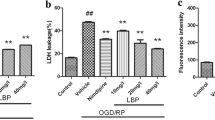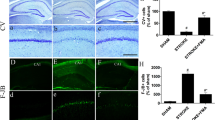Abstract
Cactus polysaccharides (CP), some of the active components in Opuntia dillenii Haw have been reported to display neuroprotective effects in rat brain slices. In the present study, we investigated the neuroprotective properties of CP and their potential mechanisms on brain ischemia-reperfusion injury in rats, and on oxidative stress-induced damage in PC12 cells. Male Sprague–Dawley rats with ischemia following middle cerebral artery occlusion and reperfusion were investigated. CP (200 mg/kg) significantly decreased the neurological deficit score, reduced infarct volume, decreased neuronal loss in cerebral cortex, and remarkably reduced the protein synthesis of inducible nitric oxide synthase which were induced by ischemia and reperfusion. Otherwise, the protective effect of CP was confirmed in in vitro study. CP protected PC12 cells against hydrogen peroxide (H2O2) insult. Pretreatment with CP prior to H2O2 exposure significantly elevated cell viability, reduced H2O2-induced apoptosis, and decreased both intracellular and total accumulation of reactive oxygen species (ROS) production. Furthermore, CP also reversed the upregulation of Bax/Bcl-2 mRNA ratio, the downstream cascade following ROS. These results suggest that CP may be a candidate compound for the treatment of ischemia and oxidative stress-induced neurodegenerative disease.







Similar content being viewed by others
References
Aravind L, Dixit VM, Koonin EV (1999) The domains of death: evolution of the apoptosis machinery. Trends Biochem Sci 24:47–53. doi:10.1016/S0968-0004(98)01341-3
Banfi B, Molnar G, Maturana A, Steger K, Hegedûs B, Demaurex N, Krause KH (2001) A Ca (2+)—activated NADPH oxidase in testis, spleen, and lymph nodes. J Biol Chem 276(40):37594–37601. doi:10.1074/jbc.M103034200
Barnham KJ, Masters CL, Bush AI (2004) Neurodegenerative diseases and oxidative stress. Nat Rev Drug Discov 3:205–214. doi:10.1038/nrd1330
Benedi J, Arroyo R, Romero C, Martín-Aragón S, Villar AM (2004) Antioxidant properties and protective effects of a standardized extract of Hypericum perforatum on hydrogen peroxide-induced oxidative damage in PC12 cells. Life Sci 75:1263–1276. doi:10.1016/j.lfs.2004.05.001
Boldogh I, Kruzel ML (2008) Colostrinintrade mark: an oxidative stress modulator for prevention and treatment of age-related disorders. J Alzheimers Dis 13:303–321
Bras M, Queenan B, Susin SA (2005) Programmed cell death via mitochondria: different modes of dying. Biochemistry (Mosc) 70:231–239. doi:10.1007/s10541-005-0105-4
Chen J, Zhao T, Huang D (2009) Protective effects of edaravone against cobalt chloride-induced apoptosis in PC12 cells. Neurosci Bull 25(2):67–74. doi:10.1007/s12264-009-1215-6
Christopherson KS, Bredt DS (1997) Nitric oxide in excitable tissues: physiological roles and disease. J Clin Invest 100(10):2424–2429. doi:10.1172/JCI119783
Colasanti M, Suzuki H (2000) The dual personality of NO. Trends Pharmacol Sci 21:249–252. doi:10.1016/S0165-6147(00)01499-1
Feugang JM, Konarski P, Zou DM, Stintzing FC, Zou CP (2006) Nutritional and medicinal use of Cactus pear (Opuntia spp.) cladodes and fruits. Front Biosci 11:2574–2589. doi:10.2741/1992
Finkel T, Holbrook NJ (2000) Oxidants, oxidative stress and the biology of aging. Nature 408:239–247. doi:10.1038/35041687
Ginsberg MD, Busto R (1989) Rodent models of cerebral ischemia. Stroke 20:1627–1642
Guo Y, Li P, Yuan H (2008) Relationship between effects of ganoderma lucidum polysaccharides on learning and memory in Alzheimer s disease rats and apoptosis of hippocampus cells. Chinese J Anat 31(3):376–393
Halliwell B, Gutteridge JMC (1999) Hydrogen peroxide. In: Halliwell B, Gutteridge JMC (eds) Free radical in biology and medicine. Oxford University Press, Oxford, pp 82–83
Hiroia M, Ogiharaa T, Hiranoa K, Hasegawaa M, Morinobua T, Tamaia H, Niki E (2005) Regulation of apoptosis by glutathione redox state in PC12 cells exposed simultaneously to iron and ascorbic acid. Free Radic Biol Med 38:1057–1072. doi:10.1016/j.freeradbiomed.2005.01.001
Hou WC, Hsu FL, Lee MH (2002) Yam (Dioscorea batatas) tuber mucilage exhibited antioxidant activities in vitro. Planta Med 68:1072–1076. doi:10.1055/s-2002-36356
Huang X, Li Q, Guo L, Yan Z (2008a) Protection of cactus polysaccharides against H2O2-induced damage in the rat cerebral cortex and hippocampus. Neural Regen Res 3(1):14–18
Huang X, Li Q, Zhang Y, Lü Q, Guo L, Huang L, He Z (2008b) Neuroprotective effects of cactus polysaccharide on oxygen and glucose deprivation induced damage in rat brain slices. Cell Mol Neurobiol 28(4):559–568. doi:10.1007/s10571-007-9184-7
Iadecola C, Zhang F, Casey R, Clark HB, Ross ME (1996) Inducible nitric oxide synthase gene expression in vascular cells after transient focal cerebral ischemia. Stroke 27(8):1373–1380
Kenneth JL, Thomas D (2001) Analysis of relative gene expression data using real-time quantitative PCR and 2−△△Ct method. Methods 25:402–408. doi:10.1006/meth.2001.1262
Kuroda S, Siesjo BK (1997) Reperfusion damage following focal ischemia: pathophysiology and therapeutic windows. Clin Neurosci 4:199–212
Lee JC, Kim HR, Kim J, Jang YS (2002) Antioxidant property of an ethanol extract of the stem of Opuntia ficus-indica var. saboten. J Agric Food Chem 50:6490–6496. doi:10.1021/jf020388c
Li Q, Huang XJ, He W, Ding J, Jia JT, Fu G, Wang HX, Guo LJ (2009) Neuroprotective potential of Fasudil Mesylate in brain ischemia-reperfusion injury of rats. Cell Mol Neurobiol 29(2):169–180
Longa EZ, Weinstein PR, Carlson S, Cummins R (1989) Reversible middle cerebral artery occlusion without craniectomy in rats. Stroke 20:84–91
Lopez AD (1995) Review: use of the fruits and stems of the prickly pear cactus (Opuntia spp.) into human food. Food Sci Technol Int 1:65–74. doi:10.1177/108201329500100202
Lu ZL, Feng Y, Xu DS, Lin X (2008) Distribution of polysaccharide MDG- 1 after single intravenous dose in rats. Her Med 27(5):497–500
Moon JH, Kim SY, Lee HG, Kim SU, Lee YB (2008) Activation of nicotinic acetylcholine receptor prevents the production of reactive oxygen species in fibrillar beta amyloid peptide (1–42)-stimulated microglia. Exp Mol Med 40:11–18. doi:10.3858/emm.2008.40.1.11
Morton JF (1990) Mucilaginous plants and their uses in medicine. J Ethnopharmacol 29:245–266. doi:10.1016/0378-8741(90)90036-S
O’Donnell ME, Tran L, Lam TI, Liu XB, Anderson SE (2004) Bumetanide inhibition of the blood-brain barrier Na-K-Cl cotransporter reduces edema formation in the rat middle cerebral artery occlusion model of stroke. J Cereb Blood Flow Metab 24:1046–1056. doi:10.1097/01.WCB.0000130867.32663.90
Olanow CW (1992) An introduction to free radical hypothesis in Parkinson’s disease. Ann Neurol 32:S2–S9. doi:10.1002/ana.410320703
Park EH, Kahng JH, Lee SH, Shin KH (2001) An anti-inflammatory principle from cactus. Fitoterapia 72:288–290. doi:10.1016/S0367-326X(00)00287-2
Qian YF, Wang HW, Yao WB, Gao XD (2008) Aqueous extract of the Chinese medicine, Danggui-Shaoyao-San, inhibits apoptosis in hydrogen peroxide-induced PC12 cells by preventing cytochrome c release and inactivating of caspase cascade. Cell Biol Int 32(2):304–311
Qin C, Huang K, Xu H (2002) Protective effect of polysaccharide from the loach on the in vitro and in vivo peroxidative damage of hepatocyte. J Nutr Biochem 13:592–597. doi:10.1016/S0955-2863(02)00193-6
Rajesh KG, Sasaguri S, Suzuki R, Maeda H (2003) Antioxidant MCI-186 inhibits mitochondrial permeability transition pore and upregulates Bcl-2 expression. Am J Physiol Heart Circ Physiol 285(5):H2171–H2178
Ravni A, Bourgault S, Lebon A, Chan P, Galas L, Fournier A, Vaudry H, Gonzalez B, Eiden LE, Vaudry D (2006) The neurotrophic effects of PACAP in PC12 cells: control by multiple transduction pathways. J Neurochem 98:321–329. doi:10.1111/j.1471-4159.2006.03884.x
Rodrigues ML, Nimrichter L, Oliveira DL, Frases S, Miranda K, Zaragoza O, Alvarez M, Nakouzi A, Feldmesser M, Casadevall A (2007) Vesicular polysaccharide export in Cryptococcus neoformans is a eukaryotic solution to the problem of fungal trans-cell wall transport. Eukaryot Cell 6(1):48–59. doi:10.1128/EC.00318-06
Rook GA, Steele J, Umar S, Dockrell HM (1985) A simple method for the solubilisation of reduced NBT, and its use as a colorimetric assay for activation of human macrophages by gamma-interferon. J Immunol Methods 82(1):161–167. doi:10.1016/0022-1759(85)90235-2
Schepetkin IA, Xie G, Kirpotina LN, Klein RA, Jutila MA, Quinn MT (2008) Macrophage immunomodulatory activity of polysaccharides isolated from Opuntia polyacantha. Int Immunopharmacol 8(10):1455–1466. doi:10.1016/j.intimp.2008.06.003
Shang P, Qian AR, Yang TH, Jia M, Mei QB, Cho CH, Zhao WM, Chen ZN (2003) Experimental study of anti-tumor effects of polysaccharides from Angelica sinensis. World J Gastroenterol 9(9):1963–1967
Spanos S, Rice S, Karagiannis P, Taylor D, Becker DL, Winston RML, Hardy K (2002) Caspase activity and expression of cell death genes during development of human preimplantation embryos. Reproduction 124:353–363. doi:10.1530/rep.0.1240353
Stintzing FC, Carle R (2005) Cactus stems (Opuntia spp.): a review on their chemistry, technology, and uses. Mol Nutr Food Res 49:175–194. doi:10.1002/mnfr.200400071
Suuronen OT, Kolehmainen P, Salminen A (2000) Protective effect of l-deprenyl against apoptosis induced by okadaic acid in cultured neuronal cells. Biochem Pharmacol 59:1589–1595. doi:10.1016/S0006-2952(00)00282-3
Swanson RA, Morton MT, Tsao-Wu G, Savalos RA, Davidson C, Sharp FR (1990) A semiautomated method for measuring brain infarct volume. J Cereb Blood Flow Metab 10:290–293
Vaudry D, Chen Y, Hsu CM, Eiden LE (2002) PC12 cells as a model to study the neurotrophic activities of PACAP. Ann N Y Acad Sci 971:491–496
Wang H, Joseph JA (1999) Quantifying cellular oxidative stress by dichlorofluorescein assay using microplate reader. Free Radic Biol Med 27(5–6):612–616. doi:10.1016/S0891-5849(99)00107-0
Watanabe T, Tahara M, Todo S (2008) The novel antioxidant edaravone: from bench to bedside. Cardiovasc ther 26(2):101–114
Acknowledgments
This work was supported by the national Foundation of Nature and Science of China (No. 30171082 and No. 30772559).
Author information
Authors and Affiliations
Corresponding author
Additional information
X.-J. Huang and Q. Li contribute equally to the paper.
Rights and permissions
About this article
Cite this article
Huang, X., Li, Q., Li, H. et al. Neuroprotective and Antioxidative Effect of Cactus Polysaccharides In Vivo and In Vitro. Cell Mol Neurobiol 29, 1211–1221 (2009). https://doi.org/10.1007/s10571-009-9417-z
Received:
Accepted:
Published:
Issue Date:
DOI: https://doi.org/10.1007/s10571-009-9417-z




